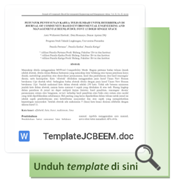Analysis of Contaminant Load Capacity of Nitrate and Phosphate in Krukut River
DOI:
https://doi.org/10.23969/jcbeem.v6i2.5993Keywords:
Krukut River, nitrate, phosphate, pollutant load, pollutant load carrying capacityAbstract
The Krukut River is one of the major rivers that flow in the Jakarta area and has an essential role in supporting public activities in the city. It is designated as raw water for drinking water. The study was conducted in the 44.30 km Krukut River flow from September 2021 until February 2022. The purpose of this study was to analyze the pollutant load capacity of nitrate and phosphate. Parameters measured in this study were temperature, turbidity, DHL, pH, DO, nitrate and phosphate. Identification of pollutant sources was carried out by field surveys. Water quality analysis is carried out following SNI (Indonesian Standard) and compared with quality standards according to Government Regulation no. 22 of 2021, as well as analysis of the pollutant load capacity of nitrate and phosphate. The search results for potential pollutants in the Krukut River are dominated by domestic waste. The air quality analysis simulation results show that the phosphate curve tends to increase with increasing distance, while the nitrate concentration fluctuates. The results of water quality analysis for nitrate parameters ranged from 1.52 mg/L – 2.94 mg/L, and phosphate ranged from 0.21 mg/L – 1.37 mg/L. The pollutant load carrying capacity results a (PLCC) average for nitrate parameters is 2431.94 kg/day, and phosphate is 48.64 kg/day, with an average pollutant load for nitrate parameters 579.84 kg/day, phosphate 243.02 kg/day.
Downloads
References
Government Regulation of the Republic of Indonesia Number 22 of 2021 concerning Implementation of Environmental Protection and Management.
Adesuyi A.A., Okafor, N.M, Njoku KL, Akinola, M., Njoku, K., & Jolaoso, A.O. (2015). Assessment of Physicochemical Characteritics of Sediments from Nwaja Creek, Niger Delta, Nigeria. Journal of Geoscience and Environment Protection, 4(1): 16–27.
Al-Badaii, F., Shuhaimi-Othman, M., & Gasim, M.B. (2013). Water Quality Assessment of the Semenyih River, Selangor, Malaysia. Journal of Chemistry, 871056, 10 p.
Herschy, R.W. (1993). The velocity–area method. Flow Meas. Instrum., 4(1): 7–10.
Hossain, M.D., Hanafi, M.M., Talib, J. & Jol, H. (2010). Effects of Nitrogen, Phosphorus and Potassium Levels on Kenaf (Hibiscus cannabinus L.) Growth and Photosynthesis under Nutrient Solution. Journal of Agricultural Science, 2(2): 49-57.
Rachmawati, I.P., Riani, E., & Riyadi, A. (2020). Water quality status and load pollution Krukut River, DKI Jakarta. Jurnal Pengelolaan Sumberdaya dan Lingkungan, 10(2): 220-233.
Patil, K., Patil, S., Patil, S., & Patil, V. (2015). Monitoring of Turbidity, PH & Temperature of Water Based on GSM. International Journal for Research in Emerging Science and Technology, 2(3): 16-21.
Rajwa-Kuligiewicz, A., Robert J. B., & Paweł M. R. 2015. Dissolved Oxygen and Water Temperature Dynamics in Lowland Rivers Over Various Timescales. J. Hydrol. Hydromech, 63(4): 353–363.
Risamasu, F. & Prayitno, H.F. (2011). Kajian Zat Hara Fosfat, Nitrit, Nitrat dan Silikat di Perairan Kepulauan Matasiri, Kalimantan Selatan. Ilmu Kelautan, 16(3): 135-142.
Simanjuntak, M. (2012). Seawater Quality Judging from Aspects of Nutrients, Dissolved Oxygen And Ph In Banggai Waters, Central Sulawesi. Journal Of Tropical Marine Science and Technology, 4(2): 290-303.
Yustiani, Y.M., Tarigan, F.K., Nurkanti, M. & Wahyuni, S. (2021). Water quality and management of Citepus River, Bandung, Indonesia. IOP Conference Series: Earth and Environmental Science, 894(1): 012006.
Zhu, S., Nyarko, E.K., & Hadzima-Nyarko, M. (2018). Modelling Daily Water Temperature From Air Temperature for The Missouri River. PeerJ, 6:e4894.














